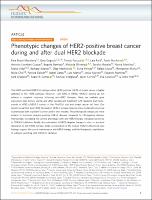Phenotypic changes of HER2-positive breast cancer during and after dual HER2 blockade

Author
Date
2020-01-20Permanent link
https://hdl.handle.net/11351/6256DOI
10.1038/s41467-019-14111-3
ISSN
2041-1723
WOS
000512537400006
PMID
31959756
Abstract
The HER2-enriched (HER2-E) subtype within HER2-positive (HER2+) breast cancer is highly addicted to the HER2 pathway. However, ∼20–60% of HER2+/HER2-E tumors do not achieve a complete response following anti-HER2 therapies. Here we evaluate gene expression data before, during and after neoadjuvant treatment with lapatinib and trastuzumab in HER2+/HER2-E tumors of the PAMELA trial and breast cancer cell lines. Our results reveal that dual HER2 blockade in HER2-E disease induces a low-proliferative Luminal A phenotype both in patient’s tumors and in vitro models. These biological changes are more evident in hormone receptor-positive (HR+) disease compared to HR-negative disease. Interestingly, increasing the luminal phenotype with anti-HER2 therapy increased sensitivity to CDK4/6 inhibition. Finally, discontinuation of HER2-targeted therapy in vitro, or acquired resistance to anti-HER2 therapy, leads to restoration of the original HER2-E phenotype. Our findings support the use of maintenance anti-HER2 therapy and the therapeutic exploitation of subtype switching with CDK4/6 inhibition.
Keywords
Breast cancer; Gene expression; OncologyBibliographic citation
Brasó-Maristany F, Griguolo G, Pascual T, Paré L, Nuciforo P, Llombart-Cussac A, et al. Phenotypic changes of HER2-positive breast cancer during and after dual HER2 blockade. Nat Commun. 2020 Jan 20;11:385.
Audience
Professionals
This item appears in following collections
- HVH - Articles científics [4476]
- VHIO - Articles científics [1250]
The following license files are associated with this item:

 Private area
Private area Contact Us
Contact Us







